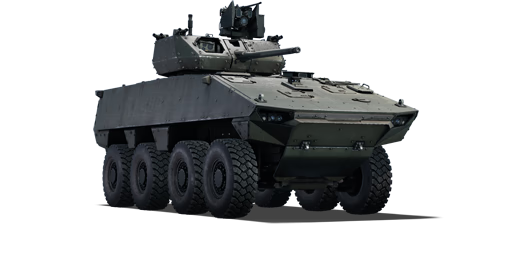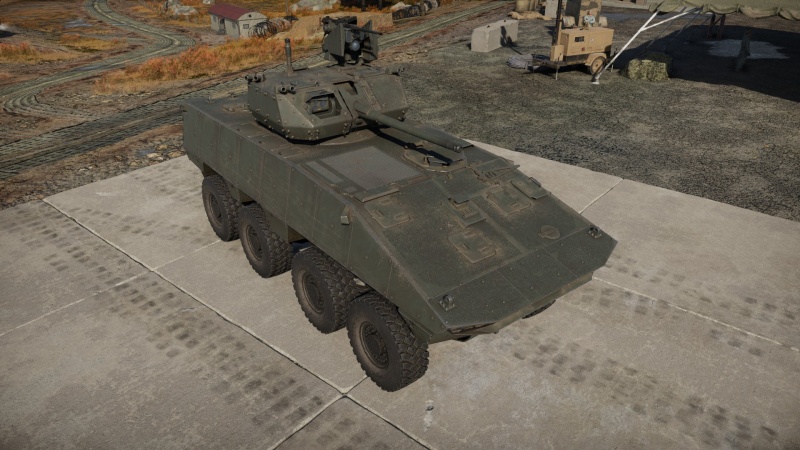Difference between revisions of "VBCI-2 (MCT30)"
cat1234611 (talk | contribs) (→Mobility) (Tag: Visual edit) |
|||
| Line 37: | Line 37: | ||
=== Mobility === | === Mobility === | ||
| − | |||
| − | |||
{{Specs-Tank-Mobility}} | {{Specs-Tank-Mobility}} | ||
<!-- ''Write about the mobility of the ground vehicle. Estimate the specific power and manoeuvrability, as well as the maximum speed forwards and backwards.'' --> | <!-- ''Write about the mobility of the ground vehicle. Estimate the specific power and manoeuvrability, as well as the maximum speed forwards and backwards.'' --> | ||
Revision as of 09:10, 3 November 2023
Contents
Description
The VBCI-2 (MCT30) is a cutting-edge infantry fighting vehicle that represents a significant evolution in armoured warfare. Developed by the French company Nexter, the VBCI-2 was created as an export version of its predecessor, the original VBCI, which was unveiled in 2008. The VBCI-2 incorporates a range of advanced technologies, including enhanced protection systems, and improved mobility. Its most distinctive feature is the integration of the formidable MCT30 turret, armed with a 30 mm autocannon and a suite of secondary weapons, making it highly capable in engaging both ground and aerial targets. The VBCI-2's adoption of advanced communication and sensor systems has significantly improved situational awareness and battlefield coordination.
It was introduced in Update "La Royale". The VBCI-2 (MCT30) boasts a formidable array of combat capabilities that place it at the forefront of modern armoured vehicles. Armed with the powerful MCT30 turret, which houses a 30 mm autocannon and supplementary armaments, the VBCI-2 possesses exceptional anti-aircraft and anti-vehicle capabilities. This enables it to engage a wide spectrum of threats with precision and versatility. The integration of advanced targeting systems, fire control technology, and stabilization mechanisms enhances its accuracy while on the move or stationary, ensuring effective engagement in dynamic combat scenarios. Furthermore, its enhanced protection systems offer substantial defense against various types of low to medium calibre weaponry. The VBCI-2's advanced sensor suite, including LWS and thermal imaging, augments situational awareness, granting its crew the ability to detect and engage targets across different terrains and weather conditions. These combat capabilities culminate in a platform that excels in both offensive and defensive operations, making the VBCI-2 a pivotal asset in modern mechanized warfare.
General info
Survivability and armour
While the VBCI-2 (MCT30) exhibits a range of advanced features, a nuanced approach characterizes its survivability. The vehicle's armour, while providing protection against various threats, might be considered less robust when confronted with highly potent anti-tank weaponry. This consideration underscores the VBCI-2's reliance on agility and mobility as key elements of its survival strategy. Additionally, the vehicle's unmanned turret, a notable feature, contributes to its survivability by reducing crew exposure to enemy fire. By leveraging its well-engineered mobility and the unmanned turret, the VBCI-2 can minimize its exposure to potential threats and rapidly change positions on the battlefield. Its ability to traverse diverse terrains efficiently enables it to exploit cover, evade incoming fire, and seek advantageous firing positions. This dynamic approach to survivability, blending mobility with tactical awareness and the advantages of an unmanned turret, allows the VBCI-2 to excel in hit-and-run tactics and swift manoeuvres, proving that a balance between armour, mobility, and advanced technology is pivotal in combat.
Armour type:
- Rolled homogeneous armour (hull, turret)
- Aluminum alloy AMS 4050 A (hull roof, suspension)
| Armour | Front (Slope angle) | Sides | Rear | Roof |
|---|---|---|---|---|
| Hull | 12 mm Upper 12 mm Lower |
12 mm Top 12 mm Bottom |
12 mm | 35 mm |
| Turret | 30 + 10 mm Turret front 30 mm Gun mantlet |
30 + 10 mm | 30 + 10 mm | 30 + 10 mm |
| Cupola | 30 + 10 mm | 10 mm | 30 + 10 mm | 30 + 10 mm |
Notes:
- Wheels are 10 mm thick
Mobility
| Game Mode | Max Speed (km/h) | Weight (tons) | Engine power (horsepower) | Power-to-weight ratio (hp/ton) | |||
|---|---|---|---|---|---|---|---|
| Forward | Reverse | Stock | Upgraded | Stock | Upgraded | ||
| Arcade | 112 | 41 | 32 | 930 | 1,145 | 29.06 | 35.78 |
| Realistic | 101 | 37 | 531 | 600 | 16.59 | 18.75 | |
Modifications and economy
Armaments
Main armament
| 30 mm Bushmaster 2 Mk.44 | Turret rotation speed (°/s) | Reloading rate (seconds) | ||||||||||||
|---|---|---|---|---|---|---|---|---|---|---|---|---|---|---|
| Mode | Capacity (Belt) | Fire rate | Vertical | Horizontal | Stabilizer | Stock | Upgraded | Full | Expert | Aced | Stock | Full | Expert | Aced |
| Arcade | 450 (75) | 200 | -10°/+40° | ±180° | Two-plane | 57.1 | 79.1 | 96.0 | 106.2 | 113.0 | 13.00 | 11.50 | 10.60 | 10.00 |
| Realistic | 35.7 | 42.0 | 51.0 | 56.4 | 60.0 | |||||||||
Ammunition
- Default: APDS · HEI-T · HEI-T
- MK266: HEI-T
- MK258: APFSDS
| Penetration statistics | |||||||
|---|---|---|---|---|---|---|---|
| Ammunition | Penetration @ 0° Angle of Attack (mm) | ||||||
| 10 m | 100 m | 500 m | 1,000 m | 1,500 m | 2,000 m | ||
| HEI-T | 9 | 8 | 6 | 5 | 3 | 3 | |
| APDS | 87 | 86 | 81 | 75 | 70 | 65 | |
| APFSDS | 116 | 115 | 110 | 104 | 99 | 93 | |
| Shell details | ||||||||||||
|---|---|---|---|---|---|---|---|---|---|---|---|---|
| Ammunition | Velocity (m/s) |
Projectile mass (kg) |
Fuse delay (m) |
Fuse sensitivity (mm) |
Explosive mass (TNT equivalent) (g) |
Ricochet | ||||||
| 0% | 50% | 100% | ||||||||||
| HEI-T | 1,080 | 0.36 | 0.1 | 0.1 | 54.4 | 79° | 80° | 81° | ||||
| APDS | 1,480 | 0.19 | - | - | - | 75° | 78° | 80° | ||||
| APFSDS | 1,430 | 0.1 | - | - | - | 78° | 80° | 81° | ||||
Ammo racks
| Full ammo |
1st rack empty |
2nd rack empty |
3rd rack empty |
4th rack empty |
5th rack empty |
6th rack empty |
Visual discrepancy |
|---|---|---|---|---|---|---|---|
| 6 | __ (+__) | __ (+__) | __ (+__) | __ (+__) | __ (+__) | __ (+__) | __ |
Machine guns
| 12.7 mm M2HB | ||||
|---|---|---|---|---|
| Mount | Capacity (Belt) | Fire rate | Vertical | Horizontal |
| Pintle | 2,000 (200) | 575 | -20°/+60° | ±180° |
Usage in battles
The VBCI-2 (MCT30) stands as a versatile and potent asset, with its capabilities extending beyond traditional ground warfare. In armoured combat, the VBCI-2 excels in a range of roles, including reconnaissance, and offensive operations. Armed with the MCT30 unmanned turret, equipped with a 30 mm autocannon and supplementary weapons, it possesses exceptional anti-vehicle capabilities, effectively engaging and neutralizing threats both on open terrain and in urban environments. When facing armoured targets, the utilization of MK258 APFSDS rounds enhances its anti-armour capabilities, penetrating protected adversaries. However, it's important to note that the APFSDS rounds may prove lacklustre when confronting Main Battle Tanks (MBTs) frontally due to their formidable armour. Nevertheless, its ability to target the sides and rear of MBTs remains formidable, potentially resulting in their destruction.
Notably, the VBCI-2's combat capabilities extend into anti-aircraft warfare. The advanced sensor suite, including Infrared Search and Track (IRST) technology and thermal imaging, enables the vehicle to detect and track aerial threats, while its rapid-firing autocannon can engage low-flying aircraft and drones. For engaging aircraft, the use of MK266 HEI-T rounds provides effective anti-aircraft firepower, deterring and countering airborne threats with precision.
Furthermore, the VBCI-2 serves a significant role in mechanized combat as a support vehicle. Its mobility allows it to rapidly manoeuvre across varied landscapes, providing repair assistance to other armoured units. The vehicle's ability to swiftly move through flanks, while offering protective cover and fire support, enhances the cohesion and effectiveness of combined arms operations.
In summary, the VBCI-2's combat uses in armoured scenarios are manifold. It excels in reconnaissance, and offensive roles, owing to its potent weaponry and agile mobility. Its anti-aircraft capabilities offer air defense augmentation, bolstering the protection of mechanized units. Additionally, the VBCI-2's role as a support vehicle enhances the overall effectiveness of mechanized combat operations by providing rapid response, support, and auxiliary functions. Through its adaptability, firepower, and versatility, the VBCI-2 remains a cornerstone of French top-tier armoured forces, capable of fulfilling diverse combat roles in the evolving landscape of warfare.
Pros and cons
Pros:
- Great mobility
- Access to APFSDS rounds with good penetration values
- Full APFSDS belts
- High turret rotation speed
- Frontally located Engine and Fuel Tank can absorb shots
Cons:
- Rather poor armour
- Slower rate of fire than 25 mm and 20 mm autocannons
- Crew can easily be knocked out
- Ammunition stored in easy-to-detonate racks
- Wheeled vehicle, speed can drop off in mud/snow and no neutral steering
- Vulnerable to overpressure damage
History
Describe the history of the creation and combat usage of the vehicle in more detail than in the introduction. If the historical reference turns out to be too long, take it to a separate article, taking a link to the article about the vehicle and adding a block "/History" (example: https://wiki.warthunder.com/(Vehicle-name)/History) and add a link to it here using the main template. Be sure to reference text and sources by using <ref></ref>, as well as adding them at the end of the article with <references />. This section may also include the vehicle's dev blog entry (if applicable) and the in-game encyclopedia description (under === In-game description ===, also if applicable).
Media
- Skins
- Videos
See also
Links to the articles on the War Thunder Wiki that you think will be useful for the reader, for example:
- reference to the series of the vehicles;
- links to approximate analogues of other nations and research trees.
External links
Paste links to sources and external resources, such as:
- topic on the official game forum;
- other literature.
| France light tanks | |
|---|---|
| AMC.34/35 | AMC.34 YR · AMC.35 (ACG.1) |
| H.35/39 | H.35 · H.39 · H.39 "Cambronne" |
| AMX-13 | AMX-13 (FL11) · AMX-13-M24 · AMX-13 · AMX-13 (SS.11) · AMX-13-90 · AMX-13 (HOT) |
| Wheeled | AML-90 · AMX-10RC · Vextra 105 |
| AMD.35 | AMD.35 · AMD.35 (SA35) |
| E.B.R. | E.B.R. (1951) · E.B.R. (1954) · E.B.R. (1963) |
| Other | FCM.36 · R.35 (SA38) · Char 25t · MARS 15 · VBCI-2 (MCT30) |
| Austria | SK-105A2 |
| Great Britain | ▄Crusader Mk.II |
| Netherlands | CV 9035NL |
| USA | LVT-4/40 · ▄M3A3 Stuart |
| France premium ground vehicles | |
|---|---|
| Light tanks | AMD.35 (SA35) · H.39 "Cambronne" · LVT-4/40 · AMX-13 (SS.11) · AMX-13-M24 · E.B.R. (1954) · E.B.R. (1963) · VBCI-2 (MCT30) |
| Medium tanks | M4A1 (FL10) · Panther "Dauphiné" · AMX-30 · AMX-30 Super · AMX-50 (TO90/930) |
| Heavy tanks | B1 ter · 2C bis · Somua SM |
| Tank destroyers | Lorraine 155 Mle.50 |





